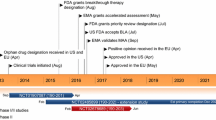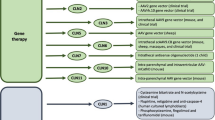Abstract
Homozygous mutations in the gene CLN1 typically result in infantile-onset neuronal ceroid lipofuscinosis, a severe progressive neurological disorder with early death. The gene CLN1 encodes the enzyme palmitoyl protein thioesterase (PPT1), which is involved in lysosomal degradation of S-fatty acylated proteins. Cysteamine bitartrate (Cystagon) has been shown to reduce the storage material in PPT1 deficient cells. We report the results of a 7-year, open label, nonrandomized trial using Cystagon in four individuals with juvenile-onset NCL resulting from milder CLN1 mutations. The Cystagon doses were gradually increased with the goal of achieving 50 mg/kg bodyweight. The disease progression was monitored with parental questionnaires in four treated individuals and five untreated controls with the same CLN1 mutations. Mononuclear leukocytes from the treated individuals were examined for submicroscopic lysosomal storage inclusions. Cystagon treatment resulted in decreased storage material in peripheral leukocytes of the treated individuals. No severe side effects were noted. An allergic rash occurred in one of the individuals that required a dose reduction. The treatment did not result in overall attenuation of the disease progression. Slower progression of the disease was observed in two of the individuals when they were analyzed separately. However, slower progression in these individuals was also observed prior to starting the treatment. This effect may have been due to the higher Cystagon dose achieved in this group, but it could also have been coincidental. The apparent lack of toxicity of Cystagon may warrant further Cystagon trials in infantile NCL, possibly in conjunction with other developing therapies.
Electronic supplementary material: The online version of this chapter (doi:10.1007/8904_2013_226) contains supplementary material, which is available to authorized users.
Access this chapter
Tax calculation will be finalised at checkout
Purchases are for personal use only
Similar content being viewed by others
References
Hobert JA, Dawson G (2006) Neuronal ceroid lipofuscinoses therapeutic strategies: past, present and future. BBA 1762:945–953
Mole SE and Williams RE (2010) Neuronal ceroid lipofuscinoses. In: Pagon RA, Bird TD, Dolan CR, Stephens K (eds) Gene reviews. [Internet] Seattle (WA), University of Washington, Seattle
Das A, Becerra CHR, Yi W, Lu JY, Siakotos AN, Wisniewski KE, Hofmann SL (1998) Molecular genetics of palmitoyl-protein thioesterase deficiency in the US. J Clin Invest 102:361–370
Hofmann SL, Lee LA, Lu YY, Vekruyse LA (1997) Palmytoyl protein thioesterase and the molecular pathogenesis of infantile neuronal ceroid lipofuscinosis. Neuropediatrics 28:27–30
Zhang Z, Butler JD, Levin SW, Wisniewski KE, Brooks SS, Mukherjee AB (2001) Lysosomal ceroid depletion by drugs: therapeutic implications for a hereditary neurodegenerative disease of childhood. Nat Med 7(4):478–484
Lu JY, Hofmann SL (2006) Inefficient cleavage of palmitoyl-protein thioesterase (PPT) substrates by aminothiols: Implications for treatment of infantile neuronal ceroid lipofuscinosis. J Inher Metab Dis 29:119–126
Goodyer P (2011) The history of cystinosis: lessons for clinical management. Int J Nephrol 2011, 929456. doi:10.4061/2011/929456
Wen GY, Wisniewski KE, Messing J, Nealy V, Gavin M, Velinov M, Jenkins EC, Brown WT (2012) Cystagon treatment for neuronal ceroid lipofuscinosis: an 8-year case study. J Clinic Case Reports 2:108. doi:10.4172/jccr.1000108
Kohlscutter A, Laabs R, Albani N (1988) Juvenile neuronal ceroid lipofuscinosis (JNCL): quantitative description of its clinical variability. Acta Paediatr Scand 77:867–872
Anderson GW, Smith VV, Brooke I, Malone M, Sebire NJ (2006) Diagnosis of neuronal ceroid lipofuscinosis (Batten disease) by electron microscopy in peripheral blood specimens. Ultrastruct Pathol 30:373–378
Gahl WA, Reed GF, Thoene JG, Schulman JD, Rizzo WB, Denman DW, Schlesselman JJ, Corden BJ, Schneider JA (1987) Cysteamine therapy for children with nephropathic cystinosis. N Engl J Med 316:971–977
Borrell-Pages M, Canals JM, Cordelieres FP, Parker JA, Pineda JR, Grange G, Bryson EA, Guillermier M, Hirsh E, Hantraye P, Cheetham ME, Neri C, Alberch J, Brouillet E, Saudou F, Humbert S (2006) Cystamine and Cysteamine increase brain levels of BDNF in Huntington disease via HSJ1b and transglutaminase. J Clin Invest 116:1410–1422
Acknowledgments
This study is dedicated to the memory of Dr. Krystyna Wisniewski. The study was initiated and continued under her supervision until her death in 2008. Without her leadership, the study would not have been possible.
Author information
Authors and Affiliations
Editor information
Editors and Affiliations
Additional information
Communicated by: Michael J Bennett, PhD Competing interests: None declared
Electronic Supplementary Material
Below is the link to the electronic supplementary material.
Synopsis
Synopsis
Cystagon treatment in patients with CLN1 mutations.
Rights and permissions
Copyright information
© 2013 SSIEM and Springer-Verlag Berlin Heidelberg
About this chapter
Cite this chapter
Gavin, M. et al. (2013). Substrate Reduction Therapy in Four Patients with Milder CLN1 Mutations and Juvenile-Onset Batten Disease Using Cysteamine Bitartrate. In: Zschocke, J., Gibson, K., Brown, G., Morava, E., Peters, V. (eds) JIMD Reports - Volume 11. JIMD Reports, vol 11. Springer, Berlin, Heidelberg. https://doi.org/10.1007/8904_2013_226
Download citation
DOI: https://doi.org/10.1007/8904_2013_226
Received:
Revised:
Accepted:
Published:
Publisher Name: Springer, Berlin, Heidelberg
Print ISBN: 978-3-642-37327-5
Online ISBN: 978-3-642-37328-2
eBook Packages: MedicineMedicine (R0)




